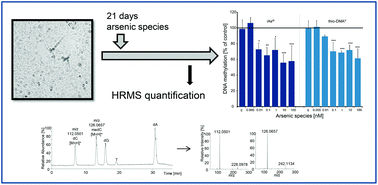Toxicity of arsenite and thio-DMAV after long-term (21 days) incubation of human urothelial cells: cytotoxicity, genotoxicity and epigenetics
Abstract
This study aims to further mechanistically understand toxic modes of action after chronic inorganic arsenic exposure. Therefore long-term incubation studies in cultured cells were carried out, to display chronically attained changes, which cannot be observed in the generally applied in vitro short-term incubation studies. Particularly, the cytotoxic, genotoxic and epigenetic effects of an up to 21 days incubation of human urothelial (UROtsa) cells with pico- to nanomolar concentrations of iAsIII and its metabolite thio-DMAV were compared. After 21 days of incubation, cytotoxic effects were strongly enhanced in the case of iAsIII and might partly be due to glutathione depletion and genotoxic effects on the chromosomal level. These results are in strong contrast to cells exposed to thio-DMAV. Thus, cells seemed to be able to adapt to this arsenical, as indicated among others by an increase in the cellular glutathione level. Most interestingly, picomolar concentrations of both iAsIII and thio-DMAV caused global DNA hypomethylation in UROtsa cells, which was quantified in parallel by 5-medC immunostaining and a newly established, reliable, high resolution mass spectrometry (HRMS)-based test system. This is the first time that epigenetic effects are reported for thio-DMAV; iAsIII induced epigenetic effects occur in at least 8000 fold lower concentrations as reported in vitro before. The fact that both arsenicals cause DNA hypomethylation at really low, exposure-relevant concentrations in human urothelial cells suggests that this epigenetic effect might contribute to inorganic arsenic induced carcinogenicity, which for sure has to be further investigated in future studies.

- This article is part of the themed collection: New Talents

 Please wait while we load your content...
Please wait while we load your content...